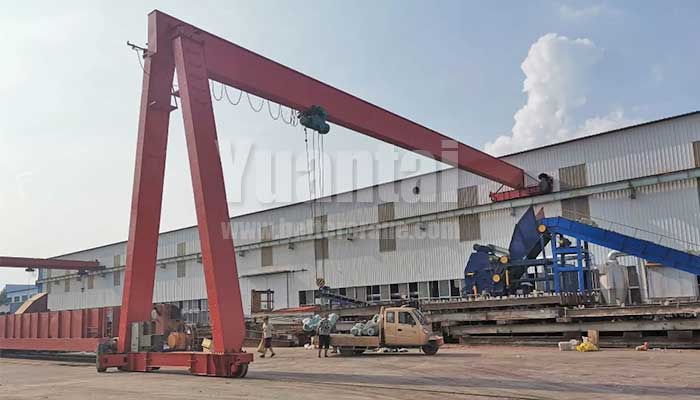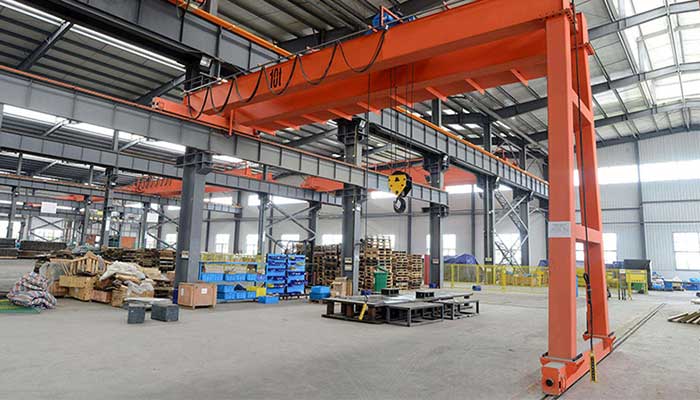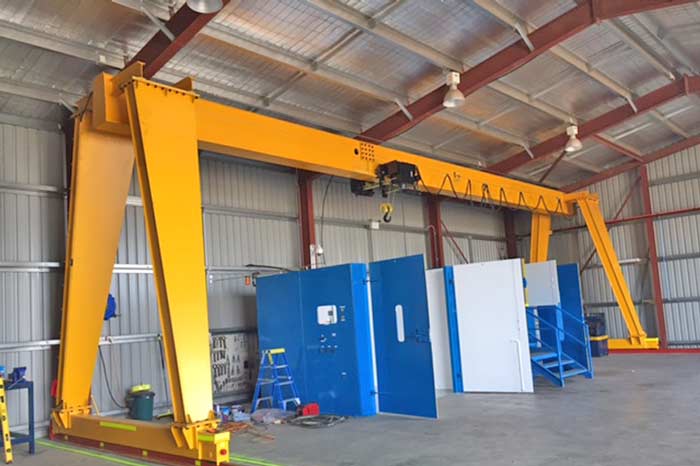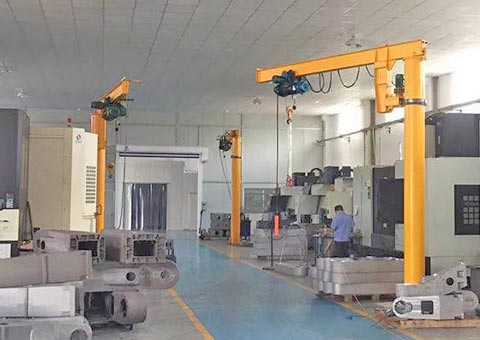What Makes Semi Gantry Crane Better?
What Makes Semi Gantry Crane Better?
Semi gantry cranes excel with single leg support, reduced footprint, cost-efficiency & adaptability in industrial applications. Get your half gantry crane!
Semi gantry cranes are versatile lifting machines characterized by their unique structural design, featuring one end supported by a runway system while the other end utilizes a single leg on the ground. This configuration allows semi gantry cranes to efficiently handle heavy loads while offering flexibility in placement and operation within industrial environments.
Single girder semi gantry crane designs for your selection
Overview of Applications
Semi gantry cranes find extensive application across various industries where efficient material handling is crucial. They are commonly employed in:
- Manufacturing facilities for assembly and production lines.
- Warehouses and distribution centers for logistics and inventory management.
- Construction sites for moving materials and equipment.
- Maintenance and repair workshops for handling heavy machinery and components.
- These cranes are valued for their ability to optimize space utilization and enhance operational efficiency in dynamic work environments.
- Purpose of Comparison with Other Crane Types
Comparing semi gantry cranes with other crane types serves several purposes:
- Structural Differences: Understanding how semi gantry cranes differ from full gantry cranes, which are fully supported on both ends by runway systems, and from overhead (bridge) cranes, which operate solely from an overhead runway.
- Space and Cost Considerations: Evaluating the space efficiency and cost-effectiveness of semi gantry cranes compared to alternative lifting solutions like jib cranes or traditional bridge cranes.
- Application Suitability: Determining the specific advantages of semi gantry cranes in different operational scenarios, including load handling capabilities, ease of installation, and adaptability to existing infrastructure.
By exploring these comparisons, decision-makers can make informed choices regarding the most suitable crane type for their operational needs and facility requirements.
Double girder semi gantry crane for sale
Design and Structure
Unique Design Features of Semi Gantry Cranes
Semi gantry cranes are distinguished by their innovative design elements, which include:
- Single Leg Support: One end of the crane is supported by a single leg structure on the ground, offering stability and structural support while minimizing the need for extensive foundation work compared to full gantry cranes.
- Connection to a Runway System: The opposite end of the crane is equipped with wheels or rollers that run along a runway system. This setup enables smooth movement and precise positioning of the crane along the designated path.
Variations in Semi Gantry Crane Configurations
Semi gantry cranes are available in different configurations to suit varying operational requirements:
- Single Girder Semi Gantry Cranes: Utilize a single bridge beam for hoist trolleys and load handling. This design is optimal for lighter loads and applications where cost efficiency is a priority.
- Double Girder Semi Gantry Cranes: Feature two parallel bridge beams that provide increased stability and higher lifting capacities. Double girder semi gantry cranes are suitable for heavier loads and applications demanding enhanced precision and control.
These variations allow organizations to choose a semi gantry crane configuration that best matches their specific operational needs, whether focused on cost-effectiveness, load capacity, or operational flexibility.
Advantages of Semi Gantry Cranes
Space Efficiency
Semi gantry cranes offer significant space-saving benefits:
- Utilization of Existing Building Structures: By leveraging existing building columns or support structures, semi gantry cranes minimize the need for additional construction, optimizing floor space for other operational needs.
- Reduced Footprint Compared to Full Gantry Cranes: Unlike full gantry cranes that require support structures on both ends, semi gantry cranes utilize a single leg support, reducing the overall footprint and allowing for more efficient use of workspace.
Cost-Effectiveness
Semi gantry cranes contribute to cost savings throughout their lifecycle:
- Lower Installation and Maintenance Costs: Simplified installation due to reduced foundation requirements and lower maintenance needs compared to full gantry cranes result in reduced initial and ongoing costs.
- Energy Efficiency and Operational Savings: Efficient design and operation minimize energy consumption, translating into operational savings over time. Additionally, lower maintenance requirements contribute to overall cost-effectiveness.
Flexibility and Adaptability
Semi gantry cranes are highly versatile and adaptable to various operational environments:
- Integration with Existing Workflows: Seamless integration with existing production or logistics workflows enhances overall efficiency and productivity.
- Customization Options for Specific Applications: Manufacturers offer customization options such as variable span lengths, lifting capacities, and control systems, enabling tailored solutions for specific operational requirements.
These advantages make semi gantry cranes a preferred choice for industries seeking efficient, cost-effective, and adaptable material handling solutions.
Operational Efficiency
Load Handling Capabilities
Semi gantry cranes excel in efficient load handling:
- Capacity Ranges and Weight Distribution: Available in a range of lifting capacities to suit diverse operational needs, from lighter loads in single girder configurations to heavier loads supported by double girder designs. The weight distribution ensures stability and safety during lifting operations.
- Precision and Control in Movement: Equipped with precise control systems, semi gantry cranes offer accurate positioning and smooth movement of loads, enhancing operational efficiency and minimizing downtime.
Ease of Operation
Operating semi gantry cranes is straightforward and user-friendly:
- User-Friendly Controls: Intuitive control interfaces allow operators to efficiently manage crane movements, including lifting, lowering, and traversing motions, ensuring precise load handling without extensive training.
- Safety Features and Mechanisms: Integrated safety features such as overload protection, emergency stop buttons, and collision avoidance systems enhance workplace safety. These mechanisms mitigate risks associated with material handling operations.
Maintenance and Durability
Semi gantry cranes are designed for longevity and minimal maintenance requirements:
- Long Lifespan with Proper Maintenance: Robust construction and quality materials contribute to extended crane lifespan when properly maintained, reducing downtime and repair costs.
- Accessibility for Repairs and Upgrades: Accessibility to critical components facilitates efficient maintenance and allows for timely upgrades to adapt to evolving operational needs, ensuring continuous reliability and performance.
These operational efficiencies make semi gantry cranes a reliable choice for industries prioritizing productivity, safety, and cost-effective material handling solutions.
Comparison with Other Crane Types

Semi Gantry vs. Full Gantry Cranes
Semi gantry cranes differ from full gantry cranes in several key aspects:
- Structural Differences: Semi gantry cranes utilize a single leg support on one end, while full gantry cranes are supported by runway systems on both ends. This structural variation affects stability, load-bearing capacity, and installation complexity.
- Space and Cost Considerations: Semi gantry cranes typically have a smaller footprint and require less initial investment and maintenance compared to full gantry cranes, making them more cost-effective for facilities with limited space or budget constraints.
Semi Gantry vs. Overhead (Bridge) Cranes
Comparing semi gantry cranes with overhead (bridge) cranes highlights their distinct characteristics:
- Installation Requirements: Semi gantry cranes require less overhead clearance and minimal groundwork compared to overhead cranes, which necessitate extensive runway systems and higher building structures for installation.
- Operational Flexibility: Semi gantry cranes offer flexibility in placement and maneuverability along the runway system, whereas overhead cranes provide unrestricted movement across the entire span, suitable for comprehensive coverage in larger work areas.

Semi Gantry vs. Jib Cranes
The differences between semi gantry cranes and jib cranes involves specific operational considerations:
- Range of Motion and Load Capacity: Semi gantry cranes offer a broader range of motion and higher load capacities compared to jib cranes, which are limited to a fixed radius of operation around their mounting point.
- Application Suitability: Semi gantry cranes are versatile for handling diverse loads and can cover larger areas within a facility, whereas jib cranes are ideal for localized lifting tasks and applications requiring precise maneuverability in restricted spaces.
These comparisons help industries assess the suitability of each crane type based on their operational requirements, spatial constraints, and budget considerations.
Typical Applications and Industries
Manufacturing Facilities
Semi gantry cranes play a crucial role in manufacturing operations:
- Assembly Lines: Facilitate the efficient movement of materials and components along assembly processes, enhancing production throughput and quality control.
- Material Handling: Enable the safe and precise positioning of heavy machinery and workpieces during manufacturing operations, optimizing workflow efficiency.
Warehouses and Distribution Centers
In warehouse and distribution environments, semi gantry cranes are essential for:
- Inventory Management: Streamline the storage and retrieval of goods and materials, maximizing storage capacity and operational efficiency.
- Loading and Unloading: Support logistics operations by efficiently loading and unloading trucks, containers, and pallets, reducing turnaround times and enhancing supply chain management.
Construction Sites
Semi gantry cranes contribute to construction site operations by:
- Material Handling: Facilitate the lifting and placement of construction materials, equipment, and prefabricated components, improving construction progress and site safety.
- Versatile Deployment: Adapt to varying site conditions and project requirements, providing flexibility in maneuverability and load capacity for construction projects of different scales.
Maintenance and Repair Workshops
Within maintenance and repair workshops, semi gantry cranes are utilized for:
- Equipment Maintenance: Assist in the servicing and repair of heavy machinery and vehicles, ensuring efficient handling and precise positioning during maintenance procedures.
- Workshop Operations: Support the movement of tools, parts, and components within the workshop environment, enhancing productivity and minimizing downtime for maintenance activities.
These applications highlight the versatility and utility of semi gantry cranes across diverse industries, addressing specific operational needs for efficient material handling and workflow optimization.
Considerations for Choosing a Semi Gantry Crane
Load Capacity and Operational Needs
When selecting a semi gantry crane, consider:
- Load Capacity: Evaluate the maximum weight requirements for lifting operations, ensuring the crane can safely handle anticipated loads without exceeding its capacity.
- Operational Needs: Assess the frequency of use, types of materials handled, and specific lifting requirements to determine the appropriate crane configuration and capabilities.
Space and Structural Constraints
Address space limitations and structural considerations:
- Footprint: Determine the available space for installing the crane, considering both floor space and overhead clearance requirements.
- Structural Support: Evaluate the adequacy of existing building structures or the need for additional support to accommodate the crane's installation and operational stability.
Budget and Cost-Benefit Analysis
Conduct a comprehensive cost analysis to ensure cost-effectiveness:
- Initial Investment: Compare upfront costs, including crane purchase, installation, and any necessary modifications or upgrades to existing infrastructure.
- Operational Costs: Consider long-term expenses such as maintenance, energy consumption, and potential productivity gains to assess overall cost-benefit.
Customization and Future Scalability
Plan for customization options and future expansion:
- Customization: Explore customization capabilities to tailor the crane's specifications, such as span length, lifting height, control systems, and safety features, to meet specific operational requirements.
- Scalability: Evaluate the crane's scalability to accommodate future growth or changes in operational demands, ensuring flexibility and adaptability over the crane's lifespan.
By carefully evaluating these considerations, businesses can make informed decisions when selecting a semi gantry crane that aligns with their operational goals, budget constraints, and facility requirements.
In summary, selecting a semi gantry crane involves careful consideration of load capacity, space constraints, budget implications, and customization options. These factors collectively determine the crane's suitability for specific operational needs and contribute to overall efficiency and cost-effectiveness in material handling.
Semi gantry cranes offer significant advantages, including space efficiency, cost-effectiveness, flexibility in deployment, and operational efficiency. Their ability to integrate with existing workflows and adapt to various industrial applications makes them a preferred choice for enhancing productivity and safety in manufacturing, warehousing, construction, and maintenance operations.




